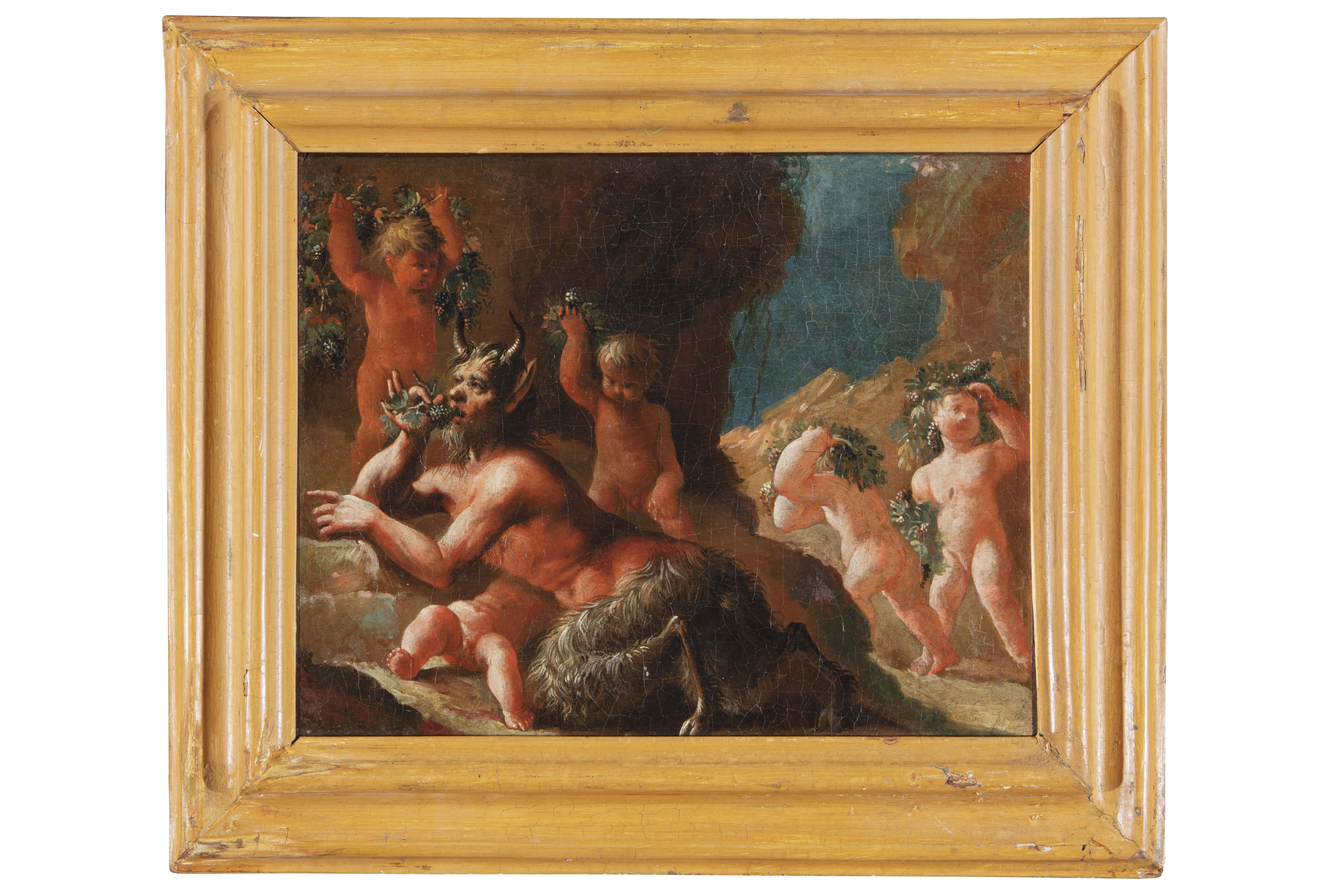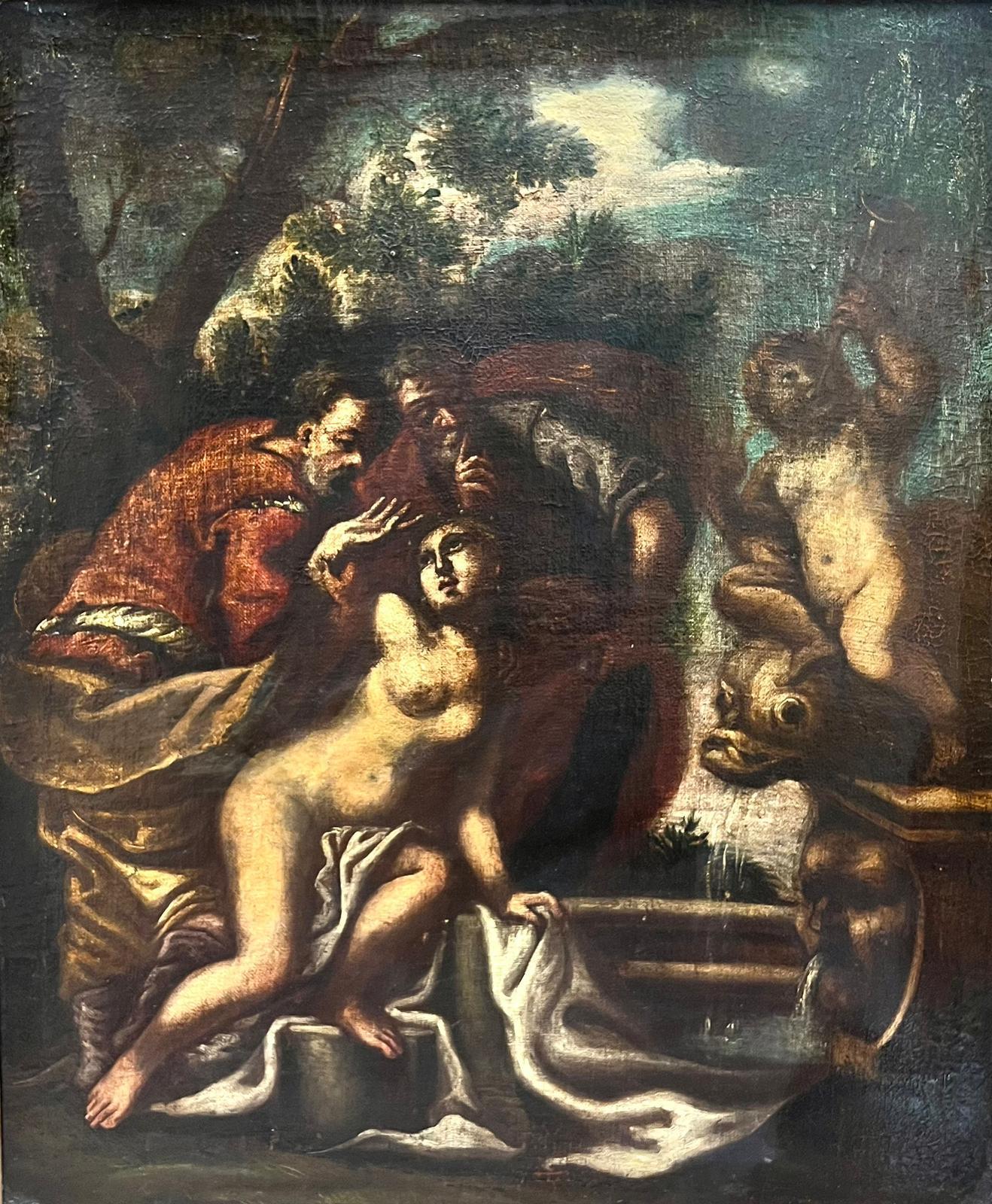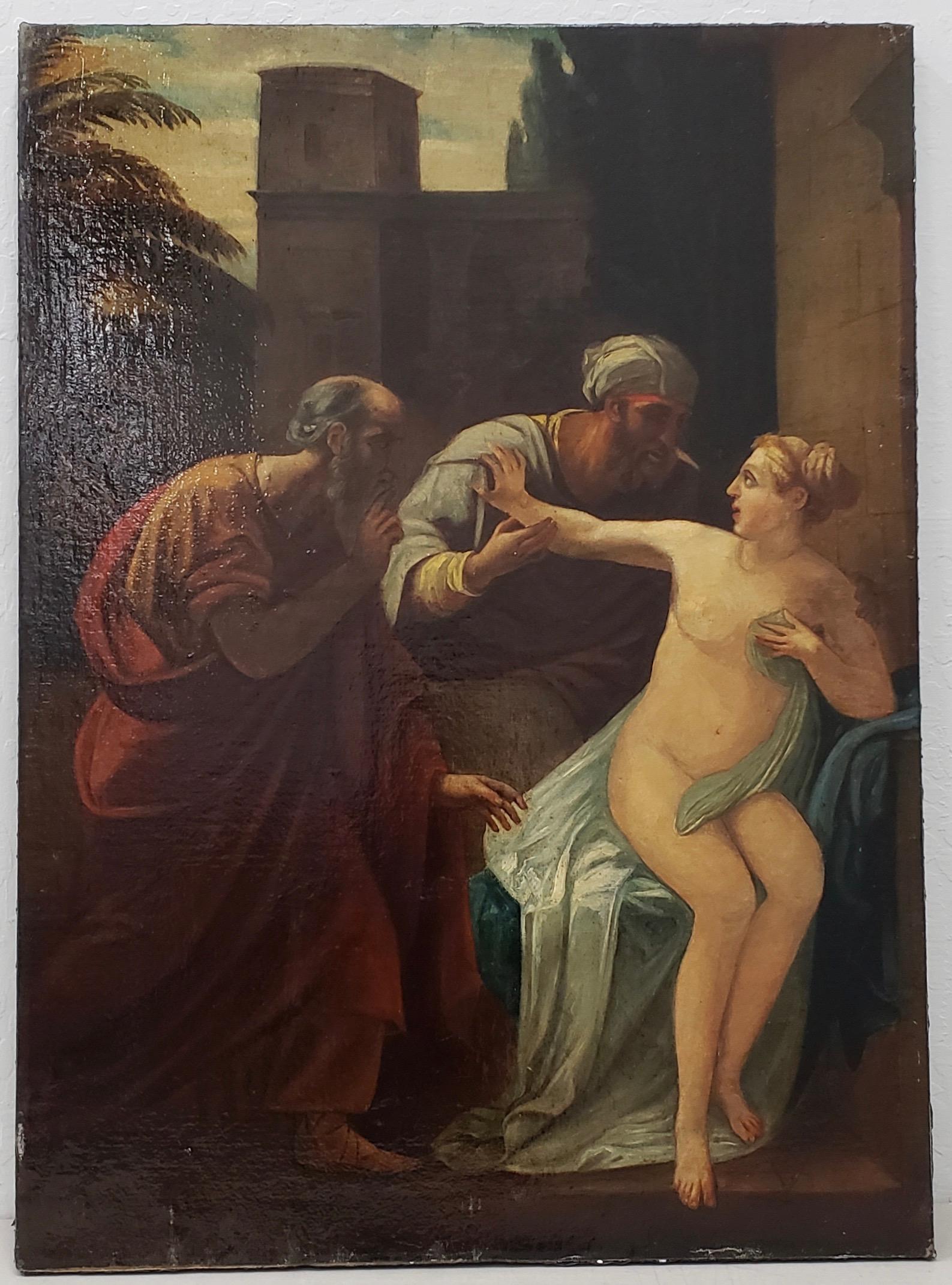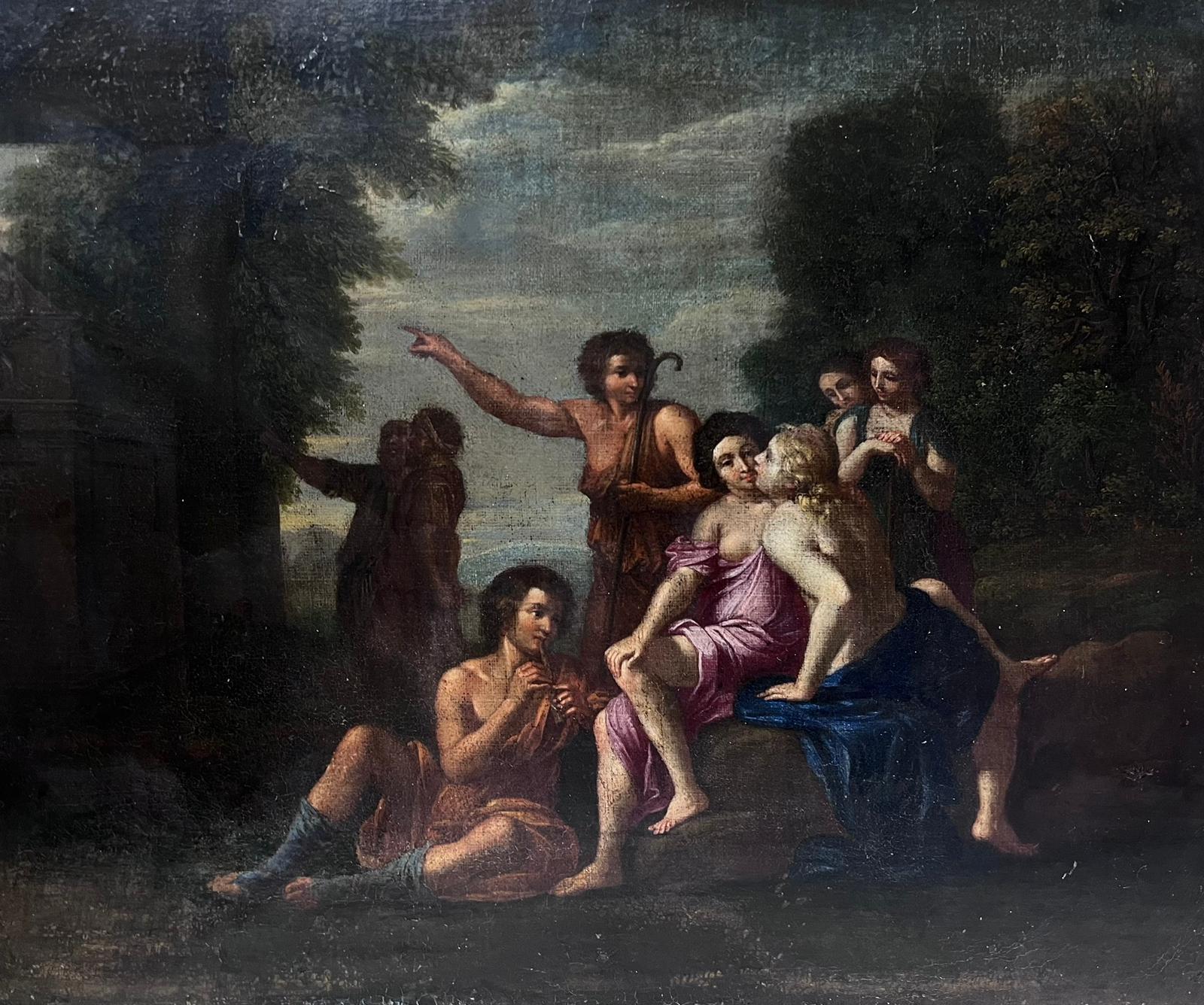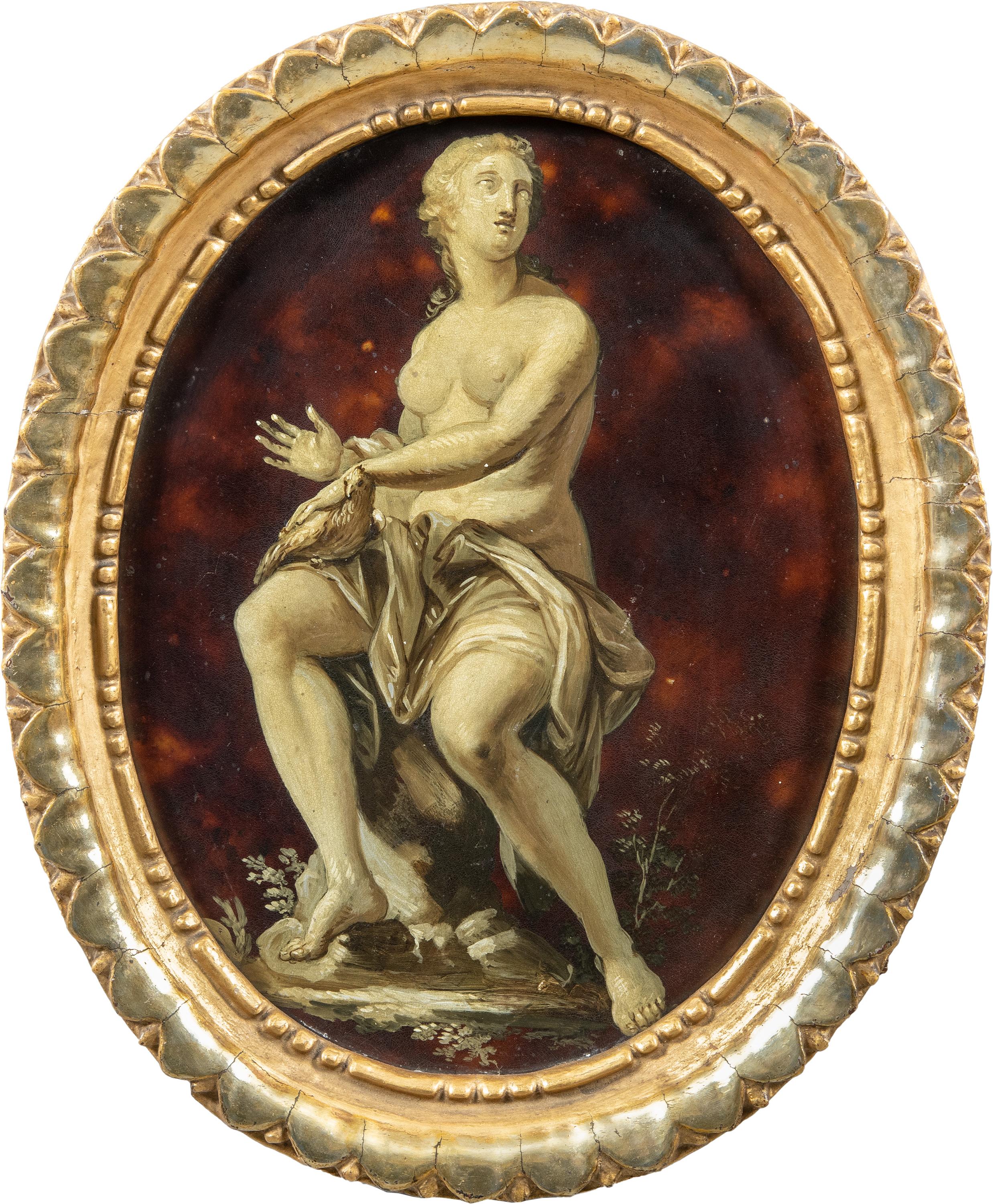Items Similar to Diana and Actaeon, a Mannerist painting after Joseph Heintz the Elder
Want more images or videos?
Request additional images or videos from the seller
1 of 14
Diana and Actaeon, a Mannerist painting after Joseph Heintz the Elder1st quarter of the 17th century
1st quarter of the 17th century
About the Item
This painting seduced us with its rich colors. Depicting Diana and her companions surprised by Actaeon, it was inspired by an engraving by Aegidius Sadeler II after a painting by Joseph Heintz the Elder now in the Kunsthistorisches Museum in Vienna.
This subject was a huge success and many artists, all anonymous, were inspired by this engraving. The vivid colors used in this painting suggest that it was probably executed in the first quarter of the 17th century by a Nordic artist, perhaps during his stay in Italy.
1. Joseph Heintz the Elder, a great artist of the Mannerist school
Joseph Heintz the Elder was born in Basel in 1564, where he apprenticed in the studio of Hans Bock the Elder (1550 - 1624). He was also inspired by the works of Hans Holbein the Younger, who had stayed in the city between 1515 and 1526.
In 1583 Joseph Heintz went to Italy and became a pupil of Hans von Aachen in Rome, before travelling to Florence and then Venice. In 1591, he was called to the court of Rudolf II in Prague, where he became his official portraitist. His stay in Prague lasted only two years, as he then returned to Italy to make copies of ancient works for the emperor before settling in Augsburg, where his son, also called Joseph, was born in 1600. His son in turn became a painter under the name of Joseph Heintz the Younger.
2. From the Vienna painting to the engraving by Aegidius Sadeler II
The original painting by Joseph Heintz the Elder is thought to have been painted between 1590 and 1600. It may have been commissioned by Rudolf II, as it reflects his taste for mythological scenes tinged with eroticism. It is now in the Kunsthistorisches Museum in Vienna (ninth picture in the gallery).
This painting enjoyed a certain renown very early on, as it was engraved by Aegidius Sadeler II (1570 - 1629), an Antwerp engraver who settled in Prague in 1597 (tenth picture in the gallery.
Although the engraving is faithful to the painting by Joseph Heintz the Elder, it differs in a few details, all of which are later reproduced in our painting (as in most other versions painted after this engraving). Starting from the left, we can see that the scabbard hanging in the tree is oriented differently, that the tree behind Actaeon has become straight, and that a tree has been added to the right above the rock forming a sort of grotto. While the engraver has emphasized the muscularity of the bodies, he has given Actaeon a fuller head of hair, and quite significantly reshaped the face of the woman standing on the far right.
3. Description of our painting
The scene depicted is inspired by a famous episode from Ovid's Metamorphoses (III 138-252). After a day's hunting, Actaeon, a young hunter, stumbles upon the sacred grotto where the goddess Diana and her nymphs are bathing. Furious at having been seen, Diana sends him a few drops of water that cause him to transform into a stag. Actaeon the hunter becomes a hunted beast, and he is eventually devoured by his hounds.
Joseph Heintz focused his painting on the representation of the group formed by the goddess, wearing her attribute (a crescent moon) and leaning forward to spray Actaeon, and her nymphs. Some of them are dressing hastily, while others are still enjoying this moment of rest.
The only notable change made by our painter to the engraving is to have crowned Actaeon's head with stag horns; this variant also appears in other copies made after Sadeler's engraving.
This painting is both rudimentary and sophisticated. The picture is painted directly onto the panel without any preparatory layer to soften the striations on the wood. The bodies, whose joints are briefly outlined with a few black lines, are drawn in a vigorous and geometric manner. But the interest - and the delight - of our painting lies in the very rich range of colors chosen to illustrate this episode.
Starting from a black and white engraving, it is likely that our painter had never seen the delicate green and pink polychromy of the original painting. In this choice of colors he demonstrated a real capacity for innovation, modulating the bodies of the nymphs from milky white to more amber tones and distributing the strident colors characteristic of Mannerism in the fabrics: carmine red, parma, orange or aniseed green.
One detail is highly representative of both the narrative verve of Heintz the Elder and our painter's taste for color. Unaffected by the surrounding tumult, a blonde beauty contemplates herself in a mirror while trying on a hat. Behind her is the most charming detail of our painting: a turbaned nymph who, like a child, hides behind the three fingers of her hand.
This close-up shows both the painter's skill at rendering detail (in the delicacy of the fingers partly covering the nymph’s face) and his immense skill as a colorist, since he does not hesitate to introduce a bright aniseed green alongside the astonishing azure blue cape (lined with orange!) that is resting on the lap of our blonde beauty.
4. The success of a theme spread through engraving
The engraving of Heintz the Elder’s painting ensured the success of this scene, which was widely reproduced: Marco Cannone, whom we would like to thank for his contribution, has listed 22 faithful copies, all of which were executed by anonymous artists after Sadeler's engraving (6 are on copper, 6 on wood, 9 on canvas and one on parchment). The two best-known copies are kept in two Italian museums, the Accademia in Venice and the Galeria Nazionale in Rome.
The only difference between these two copper plate versions is the color of the fabrics. In these versions, the nude bodies are closer to the original work, while in our painting they are much closer to the muscular treatment of the engraving, accentuating the Mannerist flavor of our painting.
5. Framing
We chose an Italian frame from the 17th century, whose auricular patterns are particularly well-suited to accompany this debauchery of flesh and swirl of colors.
Main bibliographical reference :
Jürgen Zimmer - Joseph Heintz der Ältere als Maler (1564 -1609) - 1971
- Creation Year:1st quarter of the 17th century
- Dimensions:Height: 20.88 in (53.04 cm)Width: 26.07 in (66.22 cm)
- Medium:
- Movement & Style:
- After:Joseph Heintz the Elder (1564 - 1609, Swiss)
- Period:
- Condition:Dimensions : 14 3/8‘’ x 19 13/16 ‘’ (36.5 x 50.3 cm) - Framed: 20 7/8’’ x 26 1/16’’ (53 x 66 cm) 17th century Italian carved and gilded wood frame in auricular style Provenance: private collection, Parma - Italy.
- Gallery Location:PARIS, FR
- Reference Number:1stDibs: LU1568212417162
About the Seller
5.0
Vetted Seller
These experienced sellers undergo a comprehensive evaluation by our team of in-house experts.
Established in 2020
1stDibs seller since 2021
8 sales on 1stDibs
Typical response time: 2 hours
- ShippingRetrieving quote...Ships From: PARIS, France
- Return PolicyA return for this item may be initiated within 3 days of delivery.
More From This SellerView All
- Macbeth and the Three Witches a Painting on Panel by Francesco ZuccarelliBy Francesco ZuccarelliLocated in PARIS, FRThis painting, created during Zuccarelli's stay in England, represents the decisive moment when Macbeth, together with Banquo, meets the three witches who announce that he will be Ki...Category
1760s Old Masters Landscape Paintings
MaterialsOil, Wood Panel
- Portrait of Jean-Baptiste Greuze, painted on linen by his daughter Anna GreuzeLocated in PARIS, FRThis replica of the last self-portrait of Jean-Baptiste Greuze painted in 1804, executed by his daughter Anna at her father's side and recently rediscovered, provides us with a poignant image of the great artist, represented with panache despite the disillusions of life. 1. Jean-Baptiste Greuze Jean-Baptiste Greuze was the sixth child of a roofer from Tournus and retained a certain rusticity in his behaviour from his provincial childhood, beyond his taste for describing picturesque scenes of the countryside. He initially started training with a little-known painter from Lyon, Charles Grandon, before his genius was recognised in Paris where he became a full-time student of the Académie (of Painting) in 1755. He exhibited his work for the first time at the Salon during the summer of 1755, before leaving on a trip to Italy in the company of Louis Gougenot, abbot of Chezal-Benoît. Upon his return to Paris, Greuze became a prolific painter, participating widely in the Salons held between 1759 and 1765, to which he sent no less than 63 paintings: numerous genre scenes (The Marriage Contract, The Beloved Mother), but also portraits of his family circle, of courtiers and art lovers, or of his colleagues. The Academy closed the doors of the Salons to him in 1767 for not having produced his reception piece within six months of his reception, as was the tradition. He worked actively on this painting (Emperor Severus rebukes Caracalla, his son, for trying to assassinate him ) until the summer of 1769, tackling historical and mythological subjects for the first time. Once this was completed, he was then fully admitted to the Academy, but as a genre painter, and not as an historical painter, which had been one of the greatest humiliations of his life. Greuze then refused any participation in events organised by the Academy or its successor, the Academy of Fine Arts until 1800. Abandoning history painting, he gave a new twist to genre scenes, bringing them closer to history painting, as in this pair of canvases which constitutes some of his masterpieces: The Paternal Curse: The Ungrateful Son and The Paternal Curse: The Punished Son . Married in 1759 to Anne-Gabrielle Babuti, the daughter of a Parisian bookseller, his marriage was unhappy and his wife probably frequently unfaithful. The institution of divorce enabled him to record their separation in 1793, keeping his two daughters Anna-Geneviève, born in April 1762, and Louise-Gabrielle, born in May 1764, with him. Little is known about his daughter Anna except that she was herself a painter and lived with her father until his death. It is likely that most of the paintings she produced up to that date were attributed to her father, whose technique she shared to a great extent, making it extremely difficult to establish an autonomous corpus of her paintings. Greuze died in his studio at the Louvre on March 21st 1805. The attention paid to the expressivity of his characters and the emotional charge they convey enabled Jean-Baptiste Greuze to enjoy immense popularity with the eighteenth-century public, and they still constitute Greuze's true modernity. As the artist said, "I dipped my brush in my heart". Greuze was also an exceptional draughtsman and a portraitist of immense talent and exceptional longevity who painted both the Dauphin (the son of Louis XV and father to Louis XVI) and the young Napoleon Bonaparte. 2. Greuze's self-portraits Greuze was very much influenced by Dutch paintings during all his life. While the source of his inspiration for genre scenes can be found in Gerard Dou...Category
Early 1800s Old Masters Portrait Paintings
MaterialsLinen, Oil
- Herminia and the Shepherds, a painting by Francesco de Mura (Napoli 1696 - 1782)By Francesco de MuraLocated in PARIS, FRIn this masterly painting, Francesco de Mura presents the meeting of Herminia and the shepherds, a famous episode taken from the seventh canto of Torquato Tasso's Jerusalem Delivered...Category
1760s Old Masters Figurative Paintings
MaterialsCanvas, Oil
- Virgin and Child, a paiting by David Teniers the Younger after Palma VecchioBy David Teniers the YoungerLocated in PARIS, FRProvenance: Dukes of Marlborough Collection, Blenheim Palace until its sale at Christie's London on 26 July 1886 (lot 172) English private collection until its sale at Christie's London on 11 December 1992 (lot 363) Erna Weidinger Collection (1923 - 2021) - Austria Literature : Georg Scharf - A list of the pictures in Blenheim Palace - Catalogue raisonné Part 2 - London 1862 (page 166 - number 199 "after Palma Giovane") Charles Davies...Category
1750s Old Masters Figurative Paintings
MaterialsOak, Oil
- The Parade of Swiss Guards a painting on canvas by Gabriel de Saint-AubinLocated in PARIS, FRIn this painting, Gabriel de Saint-Aubin, the great chronicler of the reign of Louis XV, takes us to the annual parade of the Swiss Guards at the Plaine de...Category
1760s Old Masters Figurative Paintings
MaterialsCanvas, Oil
- Italian Landscape with Jack Players, a painting by Gaspard Dughet (1615 - 1675)By Gaspard DughetLocated in PARIS, FRHere Gaspard Dughet offers us an idyllic vision of the Roman countryside. The stages follow one another in a perfectly structured composition, revealing here a lake, there travellers walking along, gradually leading our eye to the blue horizon. But behind its classical composition, this landscape is particularly interesting because of three anthropomorphic details that the artist has hidden, opening the way to a radically different interpretation... 1. Gaspard Dughet, a landscape artist in the light of Poussin Gaspard Dughet was born on June 4th, 1615 in Rome where his father, of French origin, was a pastry cook. He was probably named Gaspard in honour of his godfather Baron Gaspard de Morant, who was, or may have been, his father's employer. His older sister Jeanne married the painter Nicolas Poussin (1594 - 1655) on September 1st, 1630. The young Gaspard was apprenticed with his brother-in-law at the beginning of 1631, which led his entourage to name him Gaspard Poussin. The first preserved works of the painter date from the years 1633-1634 and were painted in Poussin’s studio. Around 1635, Gaspard Dughet became emancipated and began to frequent the Bamboccianti circle. In 1636, he became friends with the painter Jean Miel (1599 - 1656), but also with Pier Francesco Mola (1612 - 1666) and Pietro da Cortona (1596 - 1669). This was also the time of his first trips throughout Italy. The painter, although of French origin, appears never to have visited France. In 1646 he settled permanently in Rome. A recognized painter with a solid book of orders, he remained faithful to landscape painting throughout his life, alternating between cabinet paintings and large decorative commissions, using both oil and fresco. Nailed to his bed by rheumatic fever at the age of 58, he died on May 25, 1675. 2. Discovering an idealized landscape Beyond a relatively dark foreground that takes us into the landscape, we discover a vast bluish horizon: a plateau surrounded by deep ravines advances to the right, overhanging an expanse of water that sparkles below. A road winds through a mountainous mass as if leading us to the fortress that crowns it; another town appears in the distance at the foot of three conical mountains. The composition is rigorous, mineral, and structured by geometric volumes. The various stages in the landscape lead one to the next attracting the eye towards the horizon located in the middle of the canvas. The general impression is that of a welcoming and serene nature. In many places the paint layer has shrunk, or become transparent, revealing the dark red preparation with which the canvas was covered and accentuating the contrasts. Human presence is limited to three jack players, leaning against a mound in the foreground. Their long garments, which may evoke Roman togas, contribute to the timelessness of the scene. Close examination of the canvas reveals two other travellers on the path winding between the rocks. Made tiny by the distance, their introduction in the middle register, typical of Dughet's art, lengthens the perspective. While it is difficult to date the work of a painter who devoted his entire life to the representation of landscapes, it is certain that this painting is a work from his later years. The trees that occupied the foreground of his youthful compositions have been relegated to the sides, a stretch of water separates us from the arid mountains counterbalanced by two trees represented on the opposite bank. The introduction of this stretch of water in the middle of the landscape betrays the influence of the Bolognese and in particular of the Dominiquin (1581 - 1641) A number of similarities with a drawing in the British Museum might suggest a date around 1656-1657, since, according to Marie-Nicole Boisclair , it has been compared with the Prado's Landscape with the Repentant Magdalene, painted at that period. 3. Three amazing anthropomorphic details While some late Renaissance landscapes offer a radical double reading, allowing one to see both a face or a human body behind the representation of a landscape, it seems interesting to us to hypothesize that Gaspard Dughet had fun here by slipping in a few details that, taken in isolation, evoke human or animal figures. We will give three examples, looking closely at a cloud, the trunk of a broken tree and the top of a cliff. The main cloud could thus evoke a Christ-like face or that of an antique god...Category
1650s Old Masters Landscape Paintings
MaterialsOil
You May Also Like
- 18th century By French maestro Bacchanal Oil on canvasLocated in Milano, LombardiaDuring a festive bacchanal a big satyr is eating grapes, lying on the ground and surrounded by a large group of putti who, with festoons and vine leaves, fill and populate the pictor...Category
18th Century Old Masters Figurative Paintings
MaterialsCanvas, Oil
- Large 1700 Italian Old Master Nude Bather with Classical Figures Water FountainLocated in Cirencester, GloucestershireItalian School, circa 1700's Classical figures in landscape oil on canvas, framed framed: 36 x 32 inches canvas: 30 x 25 inches provenance: private collection, UK condition: very goo...Category
Early 18th Century Old Masters Figurative Paintings
MaterialsCanvas, Oil
- Venus and AdonisBy Baron Pierre Narcisse Guerin (workshop)Located in Paris, FRBaron Pierre Narcisse GUERIN (Circle of) 1774-1833 French Venus et Adonis (Venus and Adonis) Oil on canvas Canvas: 53" high x 39 1/2" wide Frame: ...Category
19th Century Old Masters Figurative Paintings
MaterialsCanvas, Oil
- Mid 19th Century "Susanna And The Elders" After The Old Master by MartinelliLocated in San Francisco, CAOutstanding Mid 19th century old master "Susanna and the Elders" after Martinelli Brilliant old master painting of Susanna and the Elders. Original oil on canvas. Dimensions 26.5" ...Category
Mid-19th Century Old Masters Nude Paintings
MaterialsOil, Canvas
- 17th Century French Old Master Oil Painting Classical Robed Semi Nude FiguresLocated in Cirencester, Gloucestershire17th century French School circle of Nicolas Poussin (French 1594-1665) "Figures in Arcadia" oil on canvas, unframed canvas: 16 x 20 inches provenance: private collection, England condition: very good and sound condition Nicolas Poussin was a renowned French painter of the 17th century. He is considered one of the greatest figures of classical French Baroque art...Category
17th Century Old Masters Figurative Paintings
MaterialsCanvas, Oil
- Italian painter - Late 18th century figure painting - Allegory of Peace - MetalLocated in Varmo, ITItalian painter (18th century) - Flagellation. 17 x 15 cm without frame, 21 x 19 cm with frame. Ancient alium painting on copper, in a gilded wooden frame. Condition report: The m...Category
Late 18th Century Old Masters Figurative Paintings
MaterialsMetal
